Business Law Report: Legal Aspects of Sales, Credit, and Agency
VerifiedAdded on 2020/02/17
|15
|5248
|110
Report
AI Summary
This report provides a comprehensive analysis of key aspects of business law, examining the legal framework governing commercial transactions. It delves into the sale of goods, consumer credit, agency, and product liability, offering insights into implied terms, buyer and seller remedies, and various credit agreements. The report begins with a case study involving a car purchase, exploring the legal obligations of both the buyer and seller, and the application of the Sales of Goods Act 1979. It also discusses the implications of exclusion clauses and the transfer of property. The report further examines consumer credit agreements, including bank loans, hire purchase, and credit sales, and their relevance to a car dealer. Finally, it addresses product liability and statutory provisions for faulty goods, referencing the Consumer Protection Act 1987. The report aims to provide a thorough understanding of the legal principles affecting business dealings and consumer rights.
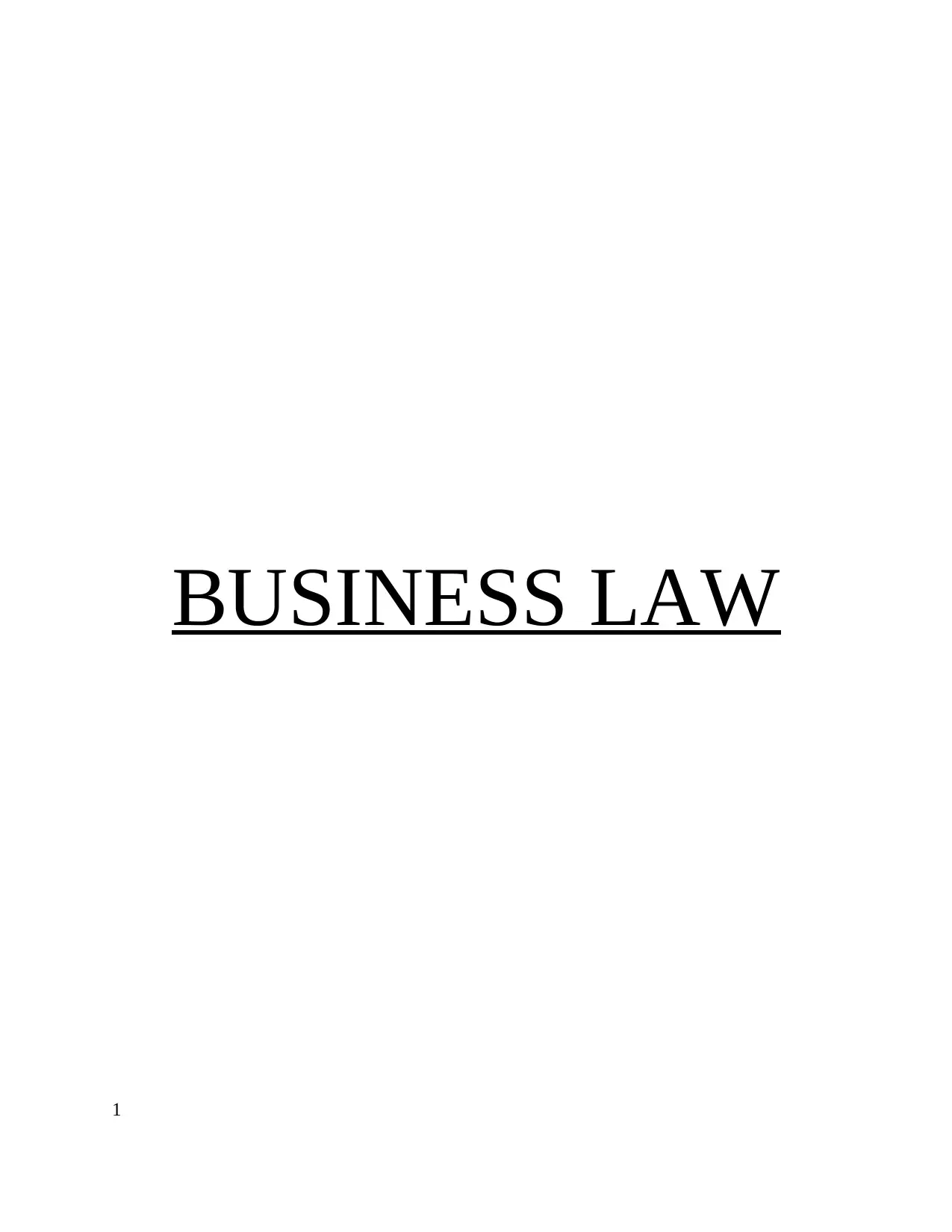
BUSINESS LAW
1
1
Paraphrase This Document
Need a fresh take? Get an instant paraphrase of this document with our AI Paraphraser
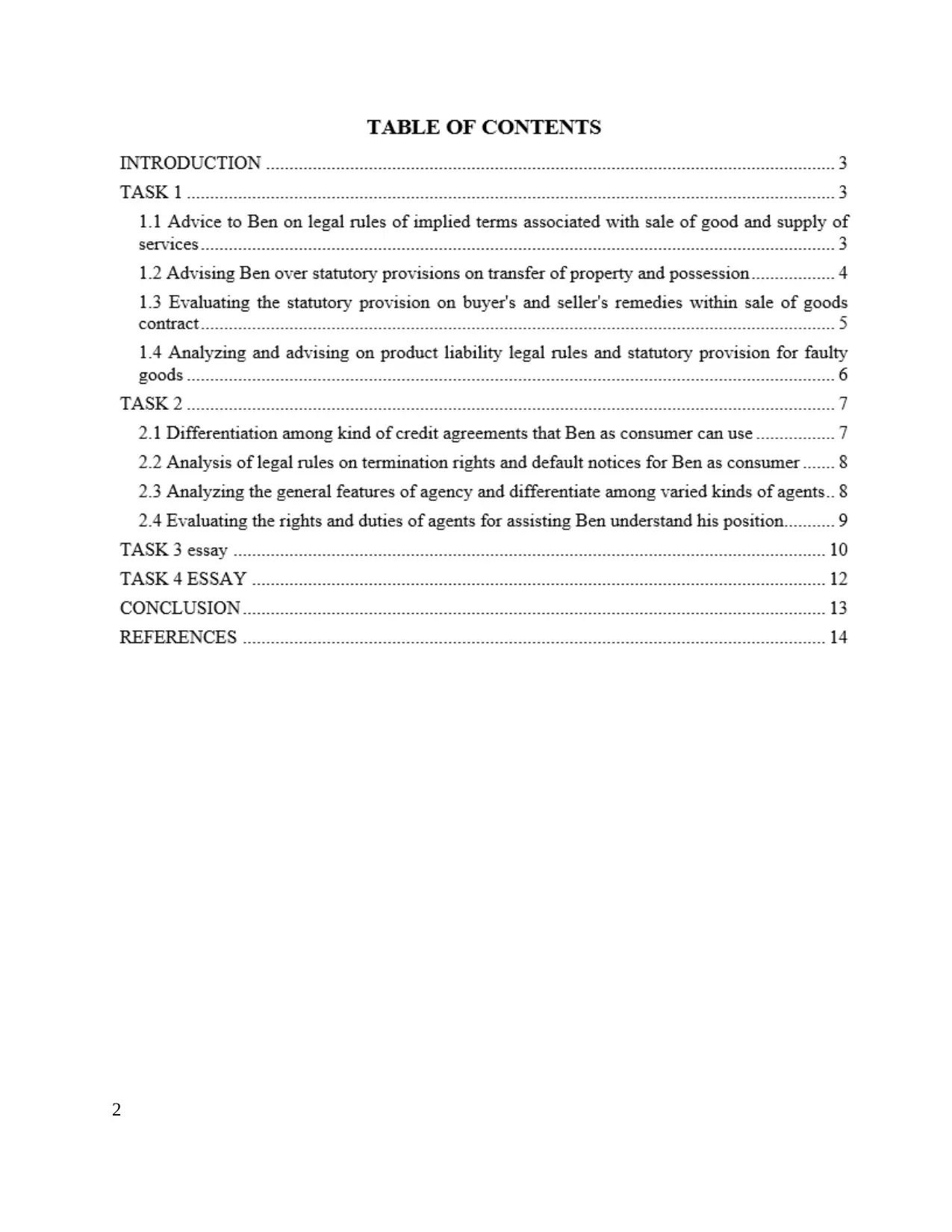
2
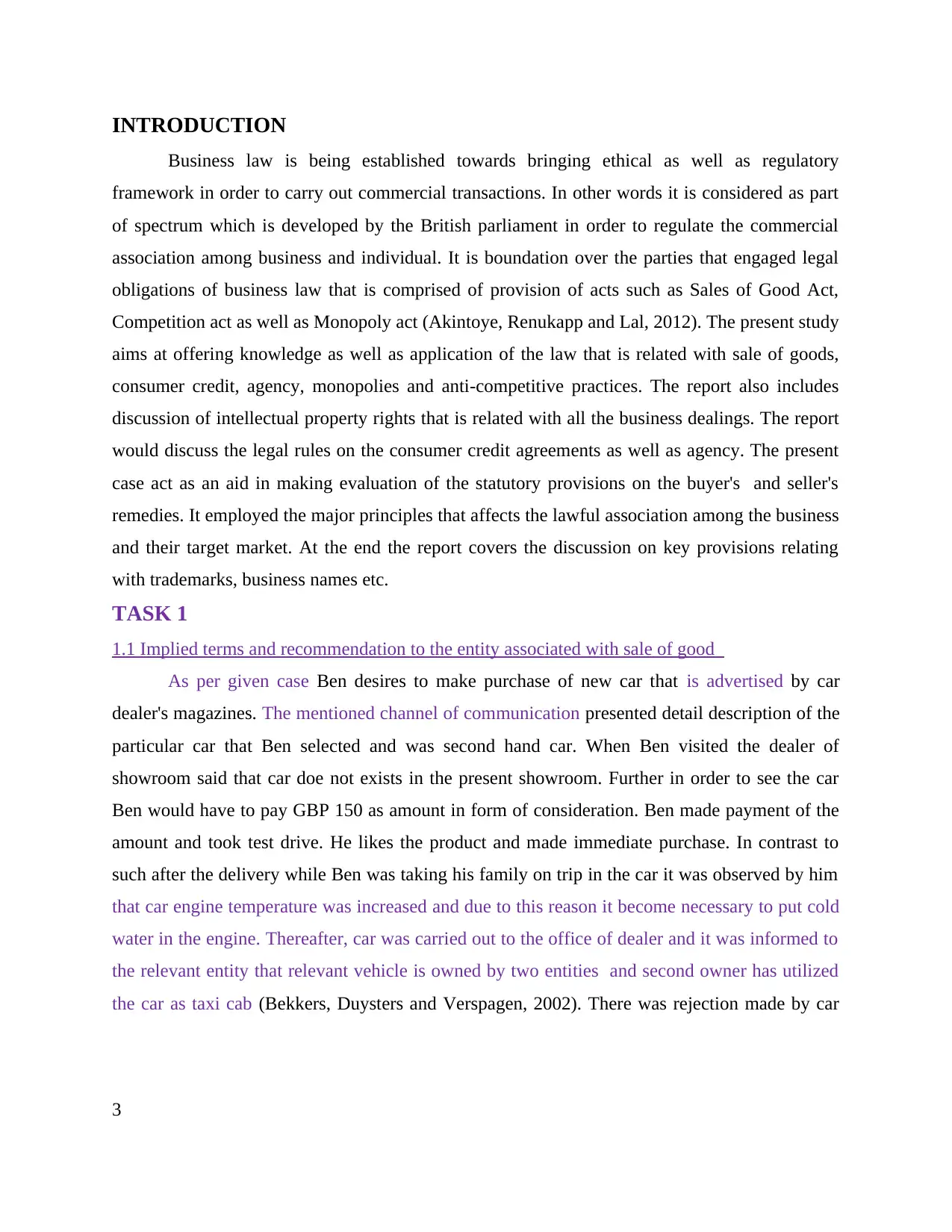
INTRODUCTION
Business law is being established towards bringing ethical as well as regulatory
framework in order to carry out commercial transactions. In other words it is considered as part
of spectrum which is developed by the British parliament in order to regulate the commercial
association among business and individual. It is boundation over the parties that engaged legal
obligations of business law that is comprised of provision of acts such as Sales of Good Act,
Competition act as well as Monopoly act (Akintoye, Renukapp and Lal, 2012). The present study
aims at offering knowledge as well as application of the law that is related with sale of goods,
consumer credit, agency, monopolies and anti-competitive practices. The report also includes
discussion of intellectual property rights that is related with all the business dealings. The report
would discuss the legal rules on the consumer credit agreements as well as agency. The present
case act as an aid in making evaluation of the statutory provisions on the buyer's and seller's
remedies. It employed the major principles that affects the lawful association among the business
and their target market. At the end the report covers the discussion on key provisions relating
with trademarks, business names etc.
TASK 1
1.1 Implied terms and recommendation to the entity associated with sale of good
As per given case Ben desires to make purchase of new car that is advertised by car
dealer's magazines. The mentioned channel of communication presented detail description of the
particular car that Ben selected and was second hand car. When Ben visited the dealer of
showroom said that car doe not exists in the present showroom. Further in order to see the car
Ben would have to pay GBP 150 as amount in form of consideration. Ben made payment of the
amount and took test drive. He likes the product and made immediate purchase. In contrast to
such after the delivery while Ben was taking his family on trip in the car it was observed by him
that car engine temperature was increased and due to this reason it become necessary to put cold
water in the engine. Thereafter, car was carried out to the office of dealer and it was informed to
the relevant entity that relevant vehicle is owned by two entities and second owner has utilized
the car as taxi cab (Bekkers, Duysters and Verspagen, 2002). There was rejection made by car
3
Business law is being established towards bringing ethical as well as regulatory
framework in order to carry out commercial transactions. In other words it is considered as part
of spectrum which is developed by the British parliament in order to regulate the commercial
association among business and individual. It is boundation over the parties that engaged legal
obligations of business law that is comprised of provision of acts such as Sales of Good Act,
Competition act as well as Monopoly act (Akintoye, Renukapp and Lal, 2012). The present study
aims at offering knowledge as well as application of the law that is related with sale of goods,
consumer credit, agency, monopolies and anti-competitive practices. The report also includes
discussion of intellectual property rights that is related with all the business dealings. The report
would discuss the legal rules on the consumer credit agreements as well as agency. The present
case act as an aid in making evaluation of the statutory provisions on the buyer's and seller's
remedies. It employed the major principles that affects the lawful association among the business
and their target market. At the end the report covers the discussion on key provisions relating
with trademarks, business names etc.
TASK 1
1.1 Implied terms and recommendation to the entity associated with sale of good
As per given case Ben desires to make purchase of new car that is advertised by car
dealer's magazines. The mentioned channel of communication presented detail description of the
particular car that Ben selected and was second hand car. When Ben visited the dealer of
showroom said that car doe not exists in the present showroom. Further in order to see the car
Ben would have to pay GBP 150 as amount in form of consideration. Ben made payment of the
amount and took test drive. He likes the product and made immediate purchase. In contrast to
such after the delivery while Ben was taking his family on trip in the car it was observed by him
that car engine temperature was increased and due to this reason it become necessary to put cold
water in the engine. Thereafter, car was carried out to the office of dealer and it was informed to
the relevant entity that relevant vehicle is owned by two entities and second owner has utilized
the car as taxi cab (Bekkers, Duysters and Verspagen, 2002). There was rejection made by car
3
⊘ This is a preview!⊘
Do you want full access?
Subscribe today to unlock all pages.

Trusted by 1+ million students worldwide
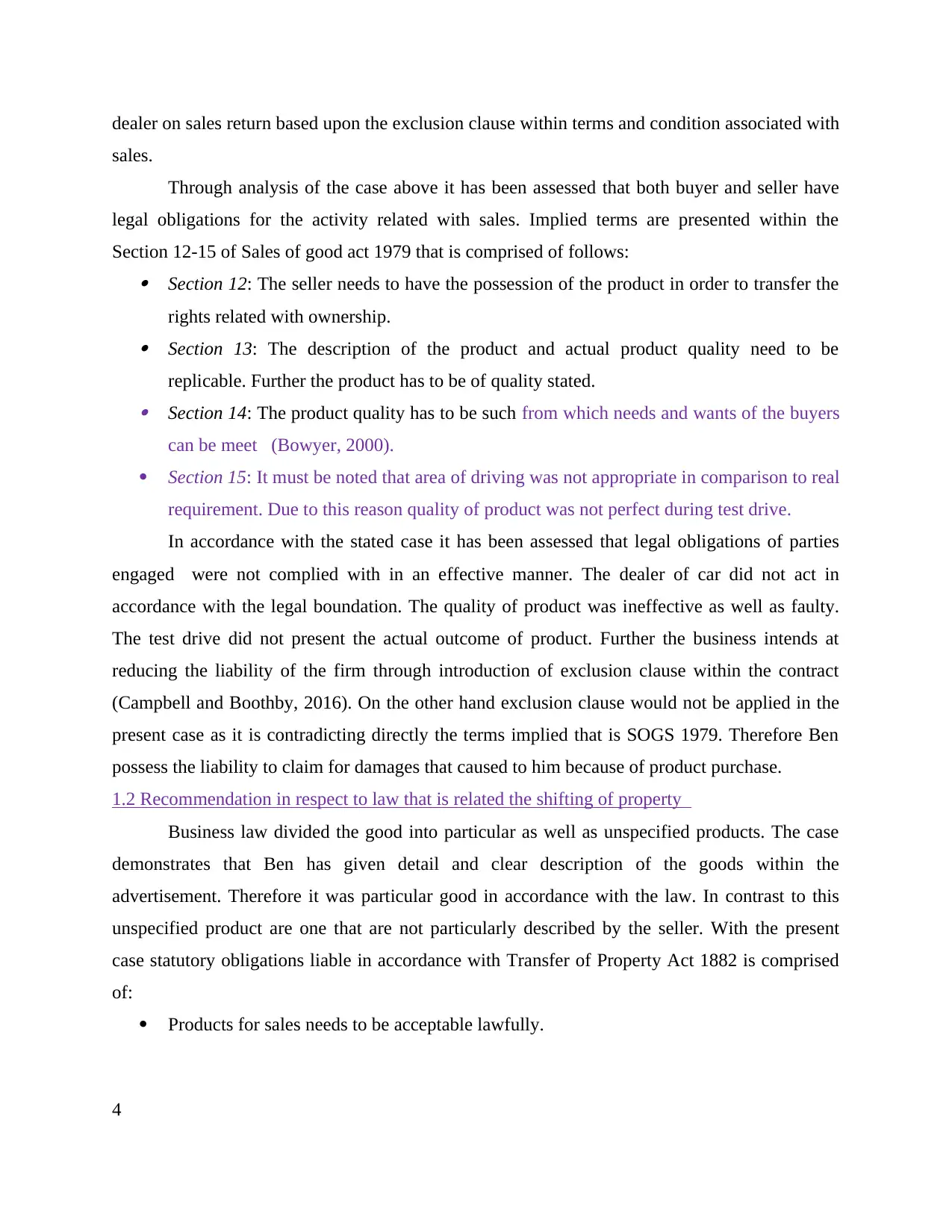
dealer on sales return based upon the exclusion clause within terms and condition associated with
sales.
Through analysis of the case above it has been assessed that both buyer and seller have
legal obligations for the activity related with sales. Implied terms are presented within the
Section 12-15 of Sales of good act 1979 that is comprised of follows: Section 12: The seller needs to have the possession of the product in order to transfer the
rights related with ownership. Section 13: The description of the product and actual product quality need to be
replicable. Further the product has to be of quality stated. Section 14: The product quality has to be such from which needs and wants of the buyers
can be meet (Bowyer, 2000).
Section 15: It must be noted that area of driving was not appropriate in comparison to real
requirement. Due to this reason quality of product was not perfect during test drive.
In accordance with the stated case it has been assessed that legal obligations of parties
engaged were not complied with in an effective manner. The dealer of car did not act in
accordance with the legal boundation. The quality of product was ineffective as well as faulty.
The test drive did not present the actual outcome of product. Further the business intends at
reducing the liability of the firm through introduction of exclusion clause within the contract
(Campbell and Boothby, 2016). On the other hand exclusion clause would not be applied in the
present case as it is contradicting directly the terms implied that is SOGS 1979. Therefore Ben
possess the liability to claim for damages that caused to him because of product purchase.
1.2 Recommendation in respect to law that is related the shifting of property
Business law divided the good into particular as well as unspecified products. The case
demonstrates that Ben has given detail and clear description of the goods within the
advertisement. Therefore it was particular good in accordance with the law. In contrast to this
unspecified product are one that are not particularly described by the seller. With the present
case statutory obligations liable in accordance with Transfer of Property Act 1882 is comprised
of:
Products for sales needs to be acceptable lawfully.
4
sales.
Through analysis of the case above it has been assessed that both buyer and seller have
legal obligations for the activity related with sales. Implied terms are presented within the
Section 12-15 of Sales of good act 1979 that is comprised of follows: Section 12: The seller needs to have the possession of the product in order to transfer the
rights related with ownership. Section 13: The description of the product and actual product quality need to be
replicable. Further the product has to be of quality stated. Section 14: The product quality has to be such from which needs and wants of the buyers
can be meet (Bowyer, 2000).
Section 15: It must be noted that area of driving was not appropriate in comparison to real
requirement. Due to this reason quality of product was not perfect during test drive.
In accordance with the stated case it has been assessed that legal obligations of parties
engaged were not complied with in an effective manner. The dealer of car did not act in
accordance with the legal boundation. The quality of product was ineffective as well as faulty.
The test drive did not present the actual outcome of product. Further the business intends at
reducing the liability of the firm through introduction of exclusion clause within the contract
(Campbell and Boothby, 2016). On the other hand exclusion clause would not be applied in the
present case as it is contradicting directly the terms implied that is SOGS 1979. Therefore Ben
possess the liability to claim for damages that caused to him because of product purchase.
1.2 Recommendation in respect to law that is related the shifting of property
Business law divided the good into particular as well as unspecified products. The case
demonstrates that Ben has given detail and clear description of the goods within the
advertisement. Therefore it was particular good in accordance with the law. In contrast to this
unspecified product are one that are not particularly described by the seller. With the present
case statutory obligations liable in accordance with Transfer of Property Act 1882 is comprised
of:
Products for sales needs to be acceptable lawfully.
4
Paraphrase This Document
Need a fresh take? Get an instant paraphrase of this document with our AI Paraphraser

The product title has to be transferred only in case the seller possess the ownership of the
product.
The product's legal rights needs to be transferred to the buyer with the product.
The sales which is conducted needs to have mutual interest for the parties that are
engaged within the transaction.
The present case reflects that all the statutory obligations by the parties can be assessed
and applied in an effective manner (Collis, 2012). On the other hand exclusion clause is not in
accordance with legal rules and regulations related with Transfer of Property Act 1882.
1.3 Evaluating the provision on buyer's and seller's remedies in respect to contract
The buyer and seller related with the product possess varied power as well as obligations
within the selling transactions. The nonperformance of any of the parties have presented the
consequences.
Remedies for buyers in sales of goods are stated as below:
Buyer possess the entitlement to claim against the repair and damages that are caused
when conducting and transfer of products that are faulty. In the present case faulty
product was car therefore Ben is entitled at claiming for the fuel, repair and charges of
cab.
The product performance is critical and in situation such is not, obtained product has to
be replaced or for particular product it needs to be refunded. In the present scenario the
product was regarded as faulty as well as performance was not gained. As particular
product it must not be replaced (Cornish, 2012). Thus the refund of product has to
performed. The caused damages which are additional in situation of product transfer as well as
possession needs to be claimed through the buyer. In the present scenario Ben has the
liability for claiming against the freight, repair as well as several extra charges paid in
relation with car.
Remedies for seller in sales of good are as under:
A seller has the entitlement towards claiming the full/ agreed price of product in form of
consideration (Dimatteo, 2016). In the present case the dealer of car has liability to claim
£10,000 for car that is second hand.
5
product.
The product's legal rights needs to be transferred to the buyer with the product.
The sales which is conducted needs to have mutual interest for the parties that are
engaged within the transaction.
The present case reflects that all the statutory obligations by the parties can be assessed
and applied in an effective manner (Collis, 2012). On the other hand exclusion clause is not in
accordance with legal rules and regulations related with Transfer of Property Act 1882.
1.3 Evaluating the provision on buyer's and seller's remedies in respect to contract
The buyer and seller related with the product possess varied power as well as obligations
within the selling transactions. The nonperformance of any of the parties have presented the
consequences.
Remedies for buyers in sales of goods are stated as below:
Buyer possess the entitlement to claim against the repair and damages that are caused
when conducting and transfer of products that are faulty. In the present case faulty
product was car therefore Ben is entitled at claiming for the fuel, repair and charges of
cab.
The product performance is critical and in situation such is not, obtained product has to
be replaced or for particular product it needs to be refunded. In the present scenario the
product was regarded as faulty as well as performance was not gained. As particular
product it must not be replaced (Cornish, 2012). Thus the refund of product has to
performed. The caused damages which are additional in situation of product transfer as well as
possession needs to be claimed through the buyer. In the present scenario Ben has the
liability for claiming against the freight, repair as well as several extra charges paid in
relation with car.
Remedies for seller in sales of good are as under:
A seller has the entitlement towards claiming the full/ agreed price of product in form of
consideration (Dimatteo, 2016). In the present case the dealer of car has liability to claim
£10,000 for car that is second hand.
5
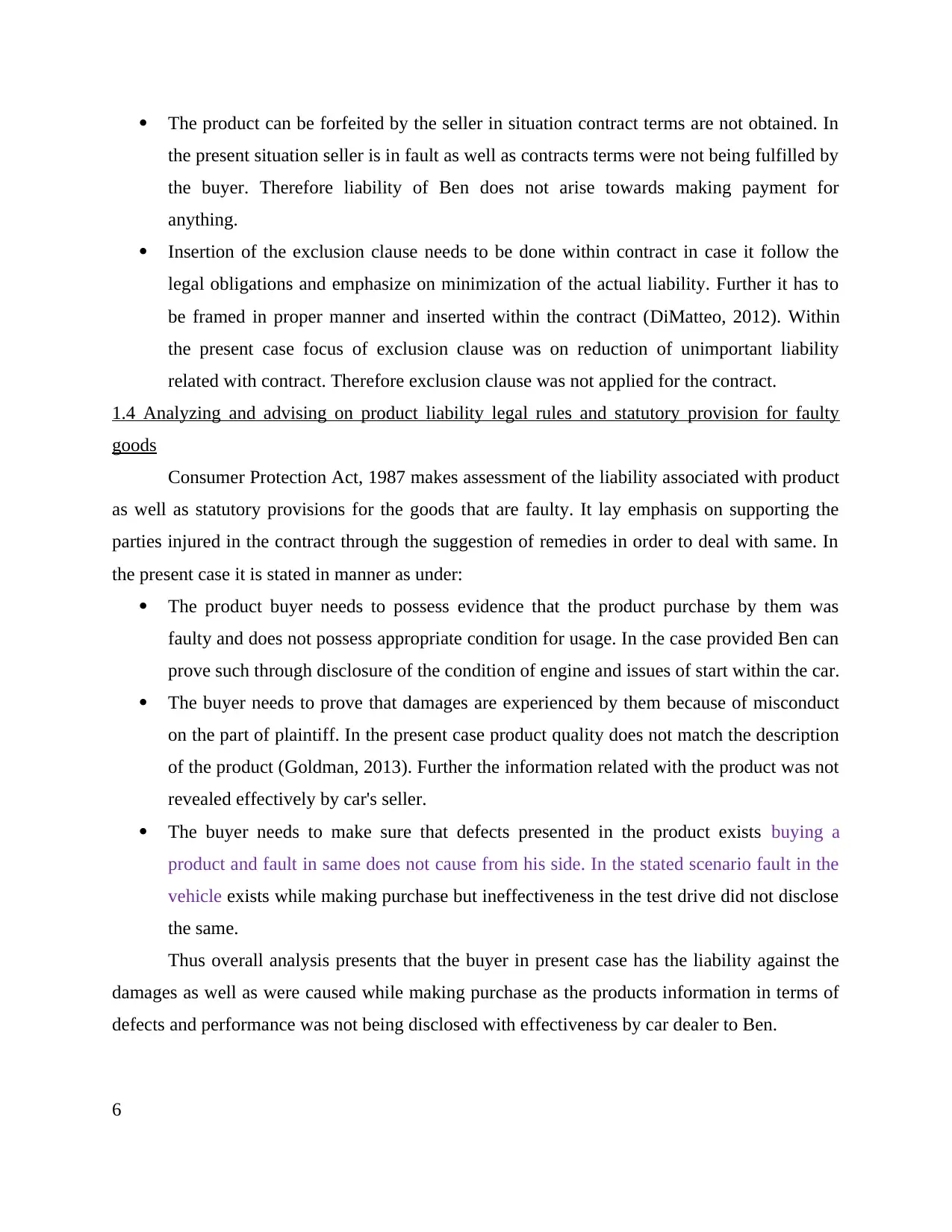
The product can be forfeited by the seller in situation contract terms are not obtained. In
the present situation seller is in fault as well as contracts terms were not being fulfilled by
the buyer. Therefore liability of Ben does not arise towards making payment for
anything.
Insertion of the exclusion clause needs to be done within contract in case it follow the
legal obligations and emphasize on minimization of the actual liability. Further it has to
be framed in proper manner and inserted within the contract (DiMatteo, 2012). Within
the present case focus of exclusion clause was on reduction of unimportant liability
related with contract. Therefore exclusion clause was not applied for the contract.
1.4 Analyzing and advising on product liability legal rules and statutory provision for faulty
goods
Consumer Protection Act, 1987 makes assessment of the liability associated with product
as well as statutory provisions for the goods that are faulty. It lay emphasis on supporting the
parties injured in the contract through the suggestion of remedies in order to deal with same. In
the present case it is stated in manner as under:
The product buyer needs to possess evidence that the product purchase by them was
faulty and does not possess appropriate condition for usage. In the case provided Ben can
prove such through disclosure of the condition of engine and issues of start within the car.
The buyer needs to prove that damages are experienced by them because of misconduct
on the part of plaintiff. In the present case product quality does not match the description
of the product (Goldman, 2013). Further the information related with the product was not
revealed effectively by car's seller.
The buyer needs to make sure that defects presented in the product exists buying a
product and fault in same does not cause from his side. In the stated scenario fault in the
vehicle exists while making purchase but ineffectiveness in the test drive did not disclose
the same.
Thus overall analysis presents that the buyer in present case has the liability against the
damages as well as were caused while making purchase as the products information in terms of
defects and performance was not being disclosed with effectiveness by car dealer to Ben.
6
the present situation seller is in fault as well as contracts terms were not being fulfilled by
the buyer. Therefore liability of Ben does not arise towards making payment for
anything.
Insertion of the exclusion clause needs to be done within contract in case it follow the
legal obligations and emphasize on minimization of the actual liability. Further it has to
be framed in proper manner and inserted within the contract (DiMatteo, 2012). Within
the present case focus of exclusion clause was on reduction of unimportant liability
related with contract. Therefore exclusion clause was not applied for the contract.
1.4 Analyzing and advising on product liability legal rules and statutory provision for faulty
goods
Consumer Protection Act, 1987 makes assessment of the liability associated with product
as well as statutory provisions for the goods that are faulty. It lay emphasis on supporting the
parties injured in the contract through the suggestion of remedies in order to deal with same. In
the present case it is stated in manner as under:
The product buyer needs to possess evidence that the product purchase by them was
faulty and does not possess appropriate condition for usage. In the case provided Ben can
prove such through disclosure of the condition of engine and issues of start within the car.
The buyer needs to prove that damages are experienced by them because of misconduct
on the part of plaintiff. In the present case product quality does not match the description
of the product (Goldman, 2013). Further the information related with the product was not
revealed effectively by car's seller.
The buyer needs to make sure that defects presented in the product exists buying a
product and fault in same does not cause from his side. In the stated scenario fault in the
vehicle exists while making purchase but ineffectiveness in the test drive did not disclose
the same.
Thus overall analysis presents that the buyer in present case has the liability against the
damages as well as were caused while making purchase as the products information in terms of
defects and performance was not being disclosed with effectiveness by car dealer to Ben.
6
⊘ This is a preview!⊘
Do you want full access?
Subscribe today to unlock all pages.

Trusted by 1+ million students worldwide
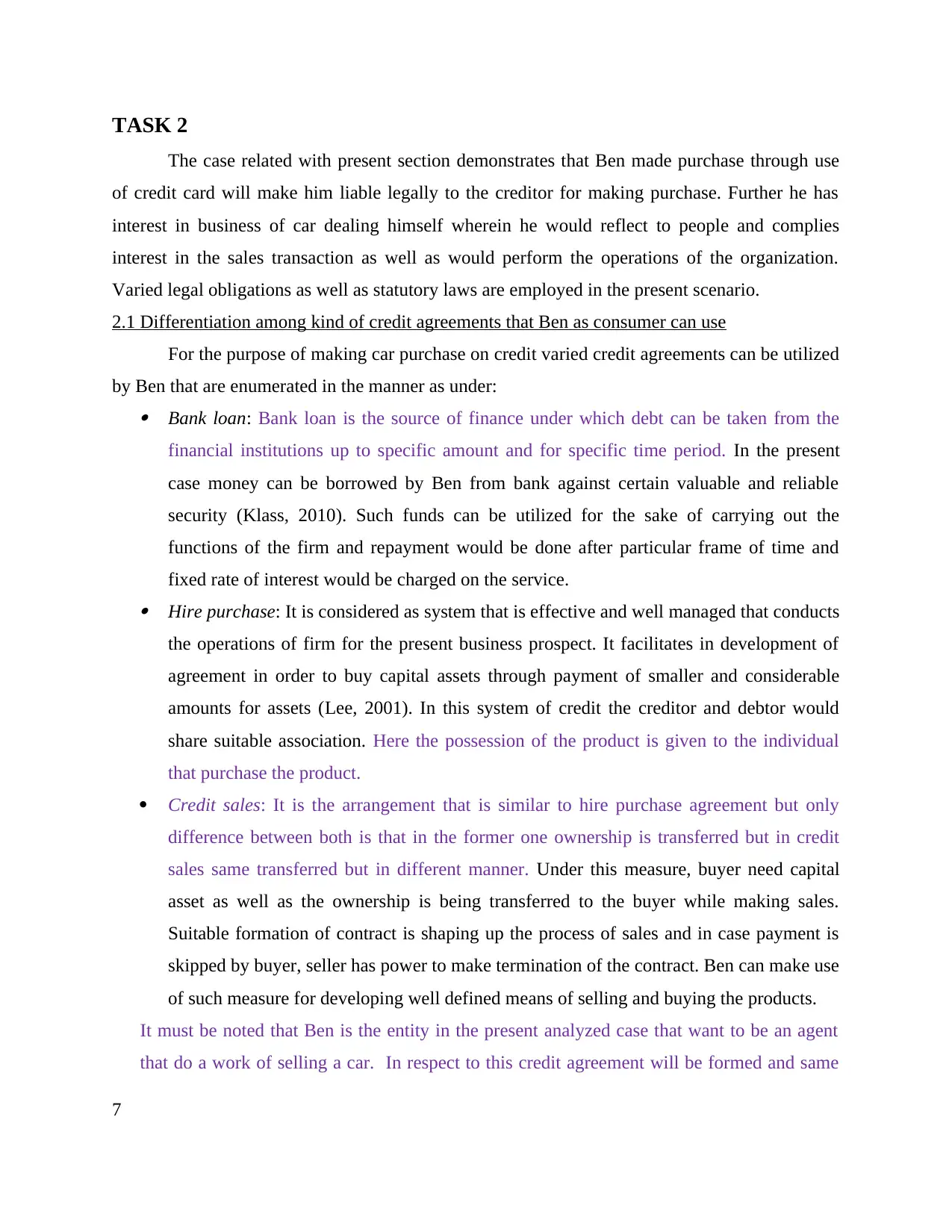
TASK 2
The case related with present section demonstrates that Ben made purchase through use
of credit card will make him liable legally to the creditor for making purchase. Further he has
interest in business of car dealing himself wherein he would reflect to people and complies
interest in the sales transaction as well as would perform the operations of the organization.
Varied legal obligations as well as statutory laws are employed in the present scenario.
2.1 Differentiation among kind of credit agreements that Ben as consumer can use
For the purpose of making car purchase on credit varied credit agreements can be utilized
by Ben that are enumerated in the manner as under: Bank loan: Bank loan is the source of finance under which debt can be taken from the
financial institutions up to specific amount and for specific time period. In the present
case money can be borrowed by Ben from bank against certain valuable and reliable
security (Klass, 2010). Such funds can be utilized for the sake of carrying out the
functions of the firm and repayment would be done after particular frame of time and
fixed rate of interest would be charged on the service. Hire purchase: It is considered as system that is effective and well managed that conducts
the operations of firm for the present business prospect. It facilitates in development of
agreement in order to buy capital assets through payment of smaller and considerable
amounts for assets (Lee, 2001). In this system of credit the creditor and debtor would
share suitable association. Here the possession of the product is given to the individual
that purchase the product.
Credit sales: It is the arrangement that is similar to hire purchase agreement but only
difference between both is that in the former one ownership is transferred but in credit
sales same transferred but in different manner. Under this measure, buyer need capital
asset as well as the ownership is being transferred to the buyer while making sales.
Suitable formation of contract is shaping up the process of sales and in case payment is
skipped by buyer, seller has power to make termination of the contract. Ben can make use
of such measure for developing well defined means of selling and buying the products.
It must be noted that Ben is the entity in the present analyzed case that want to be an agent
that do a work of selling a car. In respect to this credit agreement will be formed and same
7
The case related with present section demonstrates that Ben made purchase through use
of credit card will make him liable legally to the creditor for making purchase. Further he has
interest in business of car dealing himself wherein he would reflect to people and complies
interest in the sales transaction as well as would perform the operations of the organization.
Varied legal obligations as well as statutory laws are employed in the present scenario.
2.1 Differentiation among kind of credit agreements that Ben as consumer can use
For the purpose of making car purchase on credit varied credit agreements can be utilized
by Ben that are enumerated in the manner as under: Bank loan: Bank loan is the source of finance under which debt can be taken from the
financial institutions up to specific amount and for specific time period. In the present
case money can be borrowed by Ben from bank against certain valuable and reliable
security (Klass, 2010). Such funds can be utilized for the sake of carrying out the
functions of the firm and repayment would be done after particular frame of time and
fixed rate of interest would be charged on the service. Hire purchase: It is considered as system that is effective and well managed that conducts
the operations of firm for the present business prospect. It facilitates in development of
agreement in order to buy capital assets through payment of smaller and considerable
amounts for assets (Lee, 2001). In this system of credit the creditor and debtor would
share suitable association. Here the possession of the product is given to the individual
that purchase the product.
Credit sales: It is the arrangement that is similar to hire purchase agreement but only
difference between both is that in the former one ownership is transferred but in credit
sales same transferred but in different manner. Under this measure, buyer need capital
asset as well as the ownership is being transferred to the buyer while making sales.
Suitable formation of contract is shaping up the process of sales and in case payment is
skipped by buyer, seller has power to make termination of the contract. Ben can make use
of such measure for developing well defined means of selling and buying the products.
It must be noted that Ben is the entity in the present analyzed case that want to be an agent
that do a work of selling a car. In respect to this credit agreement will be formed and same
7
Paraphrase This Document
Need a fresh take? Get an instant paraphrase of this document with our AI Paraphraser
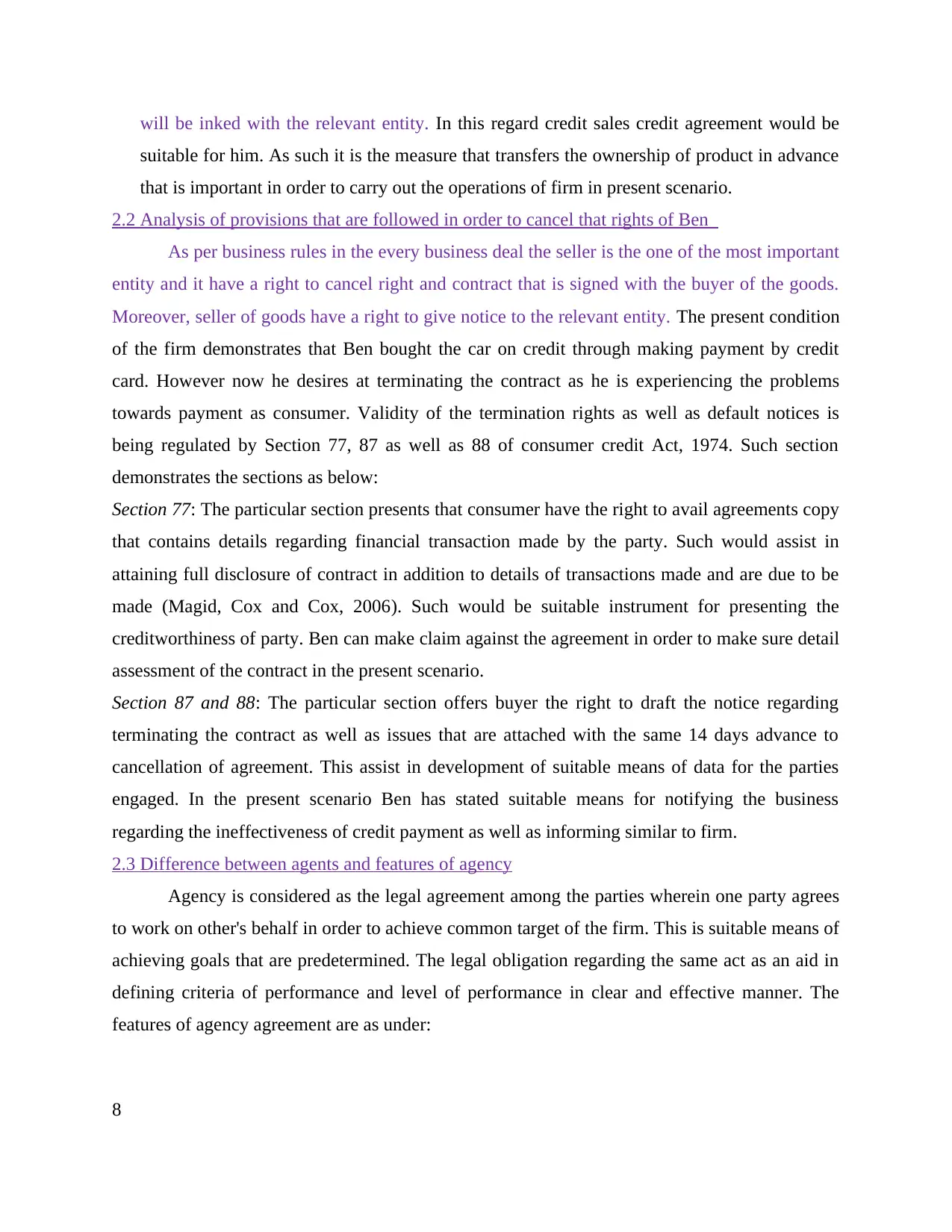
will be inked with the relevant entity. In this regard credit sales credit agreement would be
suitable for him. As such it is the measure that transfers the ownership of product in advance
that is important in order to carry out the operations of firm in present scenario.
2.2 Analysis of provisions that are followed in order to cancel that rights of Ben
As per business rules in the every business deal the seller is the one of the most important
entity and it have a right to cancel right and contract that is signed with the buyer of the goods.
Moreover, seller of goods have a right to give notice to the relevant entity. The present condition
of the firm demonstrates that Ben bought the car on credit through making payment by credit
card. However now he desires at terminating the contract as he is experiencing the problems
towards payment as consumer. Validity of the termination rights as well as default notices is
being regulated by Section 77, 87 as well as 88 of consumer credit Act, 1974. Such section
demonstrates the sections as below:
Section 77: The particular section presents that consumer have the right to avail agreements copy
that contains details regarding financial transaction made by the party. Such would assist in
attaining full disclosure of contract in addition to details of transactions made and are due to be
made (Magid, Cox and Cox, 2006). Such would be suitable instrument for presenting the
creditworthiness of party. Ben can make claim against the agreement in order to make sure detail
assessment of the contract in the present scenario.
Section 87 and 88: The particular section offers buyer the right to draft the notice regarding
terminating the contract as well as issues that are attached with the same 14 days advance to
cancellation of agreement. This assist in development of suitable means of data for the parties
engaged. In the present scenario Ben has stated suitable means for notifying the business
regarding the ineffectiveness of credit payment as well as informing similar to firm.
2.3 Difference between agents and features of agency
Agency is considered as the legal agreement among the parties wherein one party agrees
to work on other's behalf in order to achieve common target of the firm. This is suitable means of
achieving goals that are predetermined. The legal obligation regarding the same act as an aid in
defining criteria of performance and level of performance in clear and effective manner. The
features of agency agreement are as under:
8
suitable for him. As such it is the measure that transfers the ownership of product in advance
that is important in order to carry out the operations of firm in present scenario.
2.2 Analysis of provisions that are followed in order to cancel that rights of Ben
As per business rules in the every business deal the seller is the one of the most important
entity and it have a right to cancel right and contract that is signed with the buyer of the goods.
Moreover, seller of goods have a right to give notice to the relevant entity. The present condition
of the firm demonstrates that Ben bought the car on credit through making payment by credit
card. However now he desires at terminating the contract as he is experiencing the problems
towards payment as consumer. Validity of the termination rights as well as default notices is
being regulated by Section 77, 87 as well as 88 of consumer credit Act, 1974. Such section
demonstrates the sections as below:
Section 77: The particular section presents that consumer have the right to avail agreements copy
that contains details regarding financial transaction made by the party. Such would assist in
attaining full disclosure of contract in addition to details of transactions made and are due to be
made (Magid, Cox and Cox, 2006). Such would be suitable instrument for presenting the
creditworthiness of party. Ben can make claim against the agreement in order to make sure detail
assessment of the contract in the present scenario.
Section 87 and 88: The particular section offers buyer the right to draft the notice regarding
terminating the contract as well as issues that are attached with the same 14 days advance to
cancellation of agreement. This assist in development of suitable means of data for the parties
engaged. In the present scenario Ben has stated suitable means for notifying the business
regarding the ineffectiveness of credit payment as well as informing similar to firm.
2.3 Difference between agents and features of agency
Agency is considered as the legal agreement among the parties wherein one party agrees
to work on other's behalf in order to achieve common target of the firm. This is suitable means of
achieving goals that are predetermined. The legal obligation regarding the same act as an aid in
defining criteria of performance and level of performance in clear and effective manner. The
features of agency agreement are as under:
8
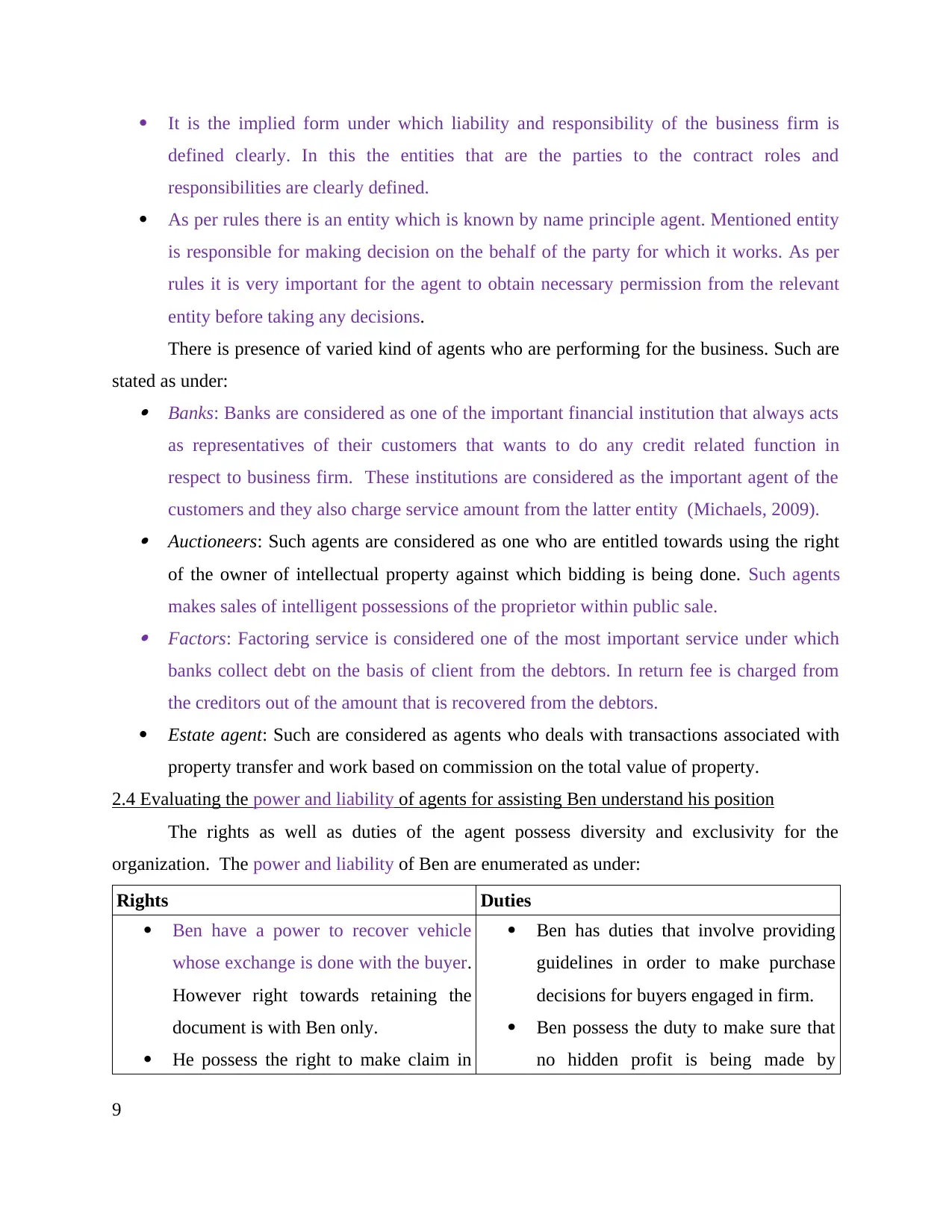
It is the implied form under which liability and responsibility of the business firm is
defined clearly. In this the entities that are the parties to the contract roles and
responsibilities are clearly defined.
As per rules there is an entity which is known by name principle agent. Mentioned entity
is responsible for making decision on the behalf of the party for which it works. As per
rules it is very important for the agent to obtain necessary permission from the relevant
entity before taking any decisions.
There is presence of varied kind of agents who are performing for the business. Such are
stated as under: Banks: Banks are considered as one of the important financial institution that always acts
as representatives of their customers that wants to do any credit related function in
respect to business firm. These institutions are considered as the important agent of the
customers and they also charge service amount from the latter entity (Michaels, 2009). Auctioneers: Such agents are considered as one who are entitled towards using the right
of the owner of intellectual property against which bidding is being done. Such agents
makes sales of intelligent possessions of the proprietor within public sale. Factors: Factoring service is considered one of the most important service under which
banks collect debt on the basis of client from the debtors. In return fee is charged from
the creditors out of the amount that is recovered from the debtors.
Estate agent: Such are considered as agents who deals with transactions associated with
property transfer and work based on commission on the total value of property.
2.4 Evaluating the power and liability of agents for assisting Ben understand his position
The rights as well as duties of the agent possess diversity and exclusivity for the
organization. The power and liability of Ben are enumerated as under:
Rights Duties
Ben have a power to recover vehicle
whose exchange is done with the buyer.
However right towards retaining the
document is with Ben only.
He possess the right to make claim in
Ben has duties that involve providing
guidelines in order to make purchase
decisions for buyers engaged in firm.
Ben possess the duty to make sure that
no hidden profit is being made by
9
defined clearly. In this the entities that are the parties to the contract roles and
responsibilities are clearly defined.
As per rules there is an entity which is known by name principle agent. Mentioned entity
is responsible for making decision on the behalf of the party for which it works. As per
rules it is very important for the agent to obtain necessary permission from the relevant
entity before taking any decisions.
There is presence of varied kind of agents who are performing for the business. Such are
stated as under: Banks: Banks are considered as one of the important financial institution that always acts
as representatives of their customers that wants to do any credit related function in
respect to business firm. These institutions are considered as the important agent of the
customers and they also charge service amount from the latter entity (Michaels, 2009). Auctioneers: Such agents are considered as one who are entitled towards using the right
of the owner of intellectual property against which bidding is being done. Such agents
makes sales of intelligent possessions of the proprietor within public sale. Factors: Factoring service is considered one of the most important service under which
banks collect debt on the basis of client from the debtors. In return fee is charged from
the creditors out of the amount that is recovered from the debtors.
Estate agent: Such are considered as agents who deals with transactions associated with
property transfer and work based on commission on the total value of property.
2.4 Evaluating the power and liability of agents for assisting Ben understand his position
The rights as well as duties of the agent possess diversity and exclusivity for the
organization. The power and liability of Ben are enumerated as under:
Rights Duties
Ben have a power to recover vehicle
whose exchange is done with the buyer.
However right towards retaining the
document is with Ben only.
He possess the right to make claim in
Ben has duties that involve providing
guidelines in order to make purchase
decisions for buyers engaged in firm.
Ben possess the duty to make sure that
no hidden profit is being made by
9
⊘ This is a preview!⊘
Do you want full access?
Subscribe today to unlock all pages.

Trusted by 1+ million students worldwide
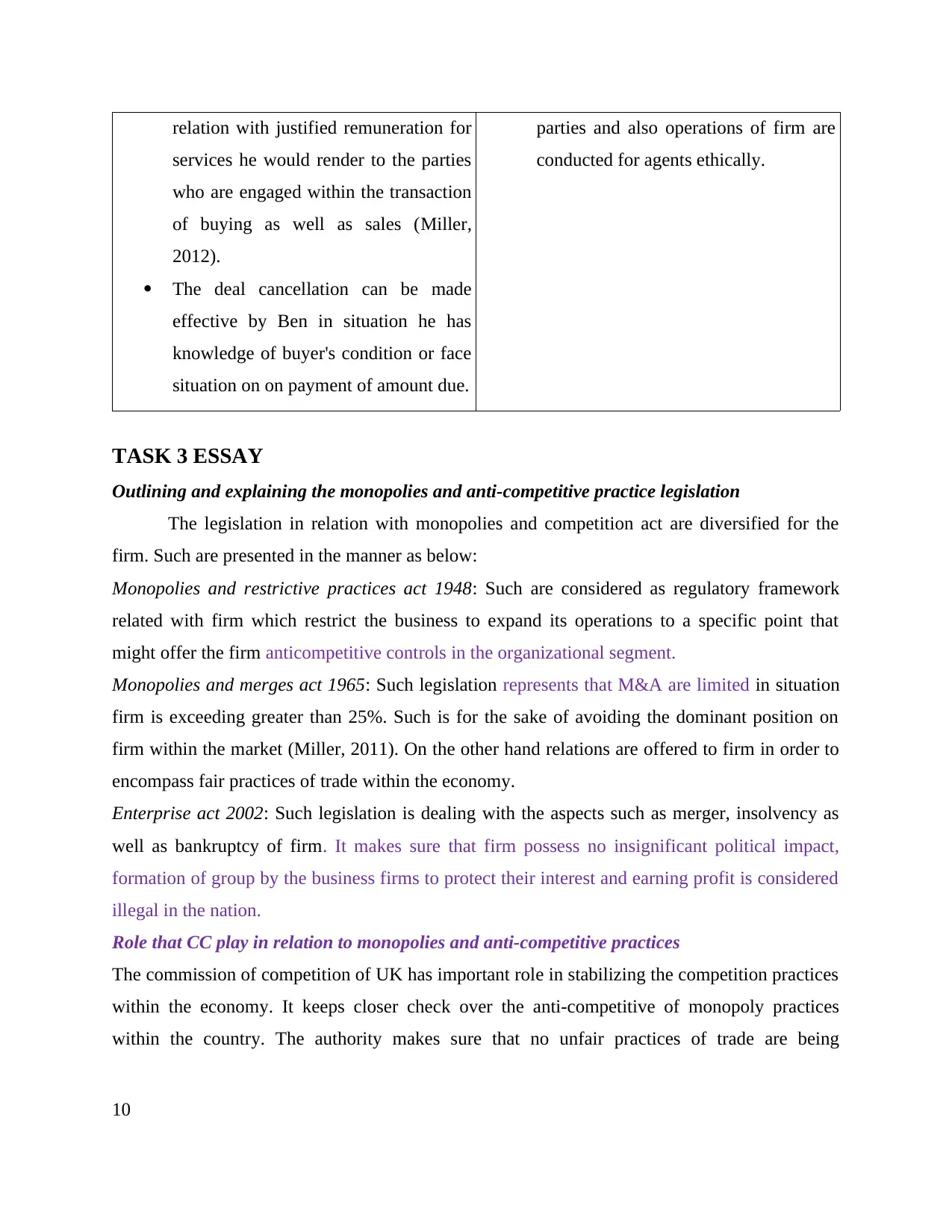
relation with justified remuneration for
services he would render to the parties
who are engaged within the transaction
of buying as well as sales (Miller,
2012).
The deal cancellation can be made
effective by Ben in situation he has
knowledge of buyer's condition or face
situation on on payment of amount due.
parties and also operations of firm are
conducted for agents ethically.
TASK 3 ESSAY
Outlining and explaining the monopolies and anti-competitive practice legislation
The legislation in relation with monopolies and competition act are diversified for the
firm. Such are presented in the manner as below:
Monopolies and restrictive practices act 1948: Such are considered as regulatory framework
related with firm which restrict the business to expand its operations to a specific point that
might offer the firm anticompetitive controls in the organizational segment.
Monopolies and merges act 1965: Such legislation represents that M&A are limited in situation
firm is exceeding greater than 25%. Such is for the sake of avoiding the dominant position on
firm within the market (Miller, 2011). On the other hand relations are offered to firm in order to
encompass fair practices of trade within the economy.
Enterprise act 2002: Such legislation is dealing with the aspects such as merger, insolvency as
well as bankruptcy of firm. It makes sure that firm possess no insignificant political impact,
formation of group by the business firms to protect their interest and earning profit is considered
illegal in the nation.
Role that CC play in relation to monopolies and anti-competitive practices
The commission of competition of UK has important role in stabilizing the competition practices
within the economy. It keeps closer check over the anti-competitive of monopoly practices
within the country. The authority makes sure that no unfair practices of trade are being
10
services he would render to the parties
who are engaged within the transaction
of buying as well as sales (Miller,
2012).
The deal cancellation can be made
effective by Ben in situation he has
knowledge of buyer's condition or face
situation on on payment of amount due.
parties and also operations of firm are
conducted for agents ethically.
TASK 3 ESSAY
Outlining and explaining the monopolies and anti-competitive practice legislation
The legislation in relation with monopolies and competition act are diversified for the
firm. Such are presented in the manner as below:
Monopolies and restrictive practices act 1948: Such are considered as regulatory framework
related with firm which restrict the business to expand its operations to a specific point that
might offer the firm anticompetitive controls in the organizational segment.
Monopolies and merges act 1965: Such legislation represents that M&A are limited in situation
firm is exceeding greater than 25%. Such is for the sake of avoiding the dominant position on
firm within the market (Miller, 2011). On the other hand relations are offered to firm in order to
encompass fair practices of trade within the economy.
Enterprise act 2002: Such legislation is dealing with the aspects such as merger, insolvency as
well as bankruptcy of firm. It makes sure that firm possess no insignificant political impact,
formation of group by the business firms to protect their interest and earning profit is considered
illegal in the nation.
Role that CC play in relation to monopolies and anti-competitive practices
The commission of competition of UK has important role in stabilizing the competition practices
within the economy. It keeps closer check over the anti-competitive of monopoly practices
within the country. The authority makes sure that no unfair practices of trade are being
10
Paraphrase This Document
Need a fresh take? Get an instant paraphrase of this document with our AI Paraphraser
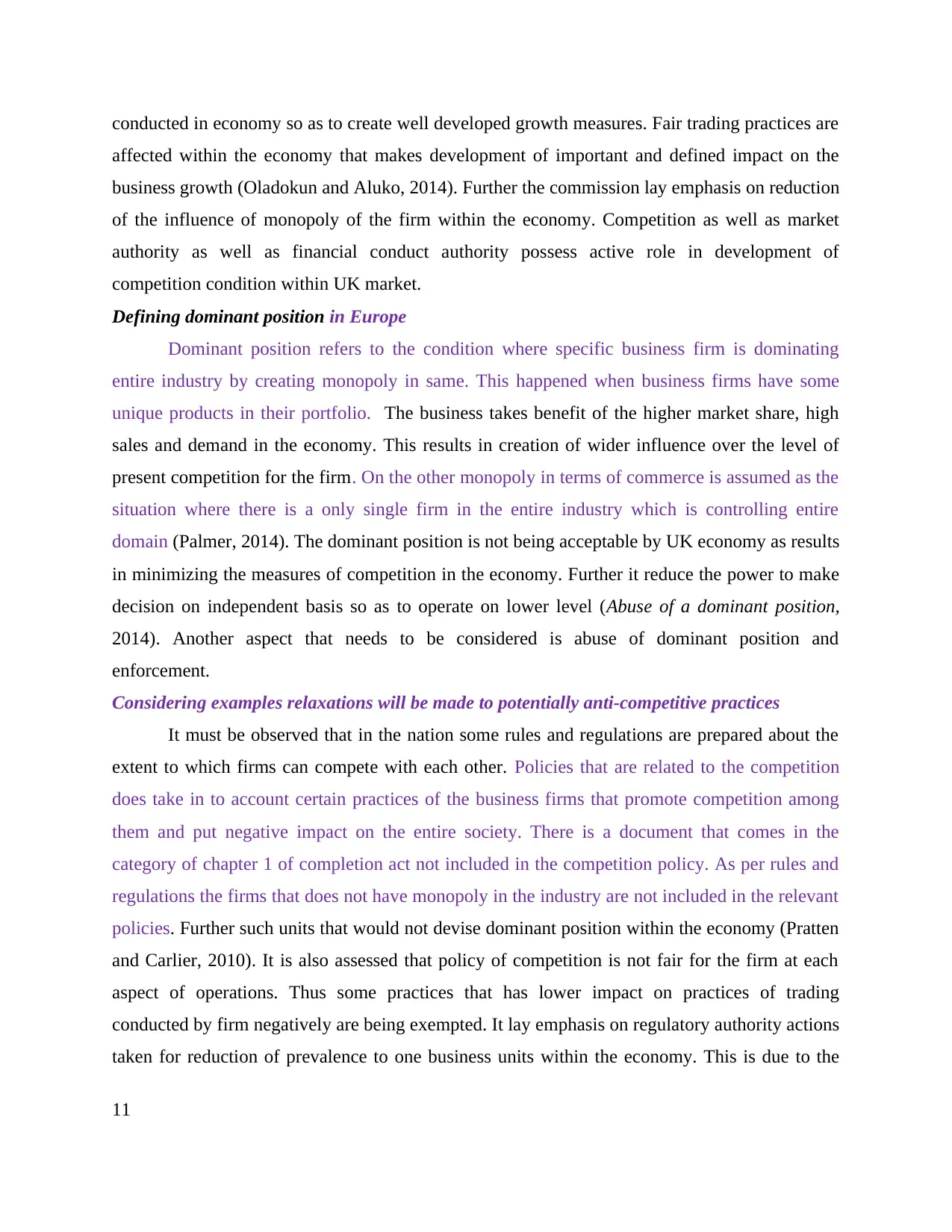
conducted in economy so as to create well developed growth measures. Fair trading practices are
affected within the economy that makes development of important and defined impact on the
business growth (Oladokun and Aluko, 2014). Further the commission lay emphasis on reduction
of the influence of monopoly of the firm within the economy. Competition as well as market
authority as well as financial conduct authority possess active role in development of
competition condition within UK market.
Defining dominant position in Europe
Dominant position refers to the condition where specific business firm is dominating
entire industry by creating monopoly in same. This happened when business firms have some
unique products in their portfolio. The business takes benefit of the higher market share, high
sales and demand in the economy. This results in creation of wider influence over the level of
present competition for the firm. On the other monopoly in terms of commerce is assumed as the
situation where there is a only single firm in the entire industry which is controlling entire
domain (Palmer, 2014). The dominant position is not being acceptable by UK economy as results
in minimizing the measures of competition in the economy. Further it reduce the power to make
decision on independent basis so as to operate on lower level (Abuse of a dominant position,
2014). Another aspect that needs to be considered is abuse of dominant position and
enforcement.
Considering examples relaxations will be made to potentially anti-competitive practices
It must be observed that in the nation some rules and regulations are prepared about the
extent to which firms can compete with each other. Policies that are related to the competition
does take in to account certain practices of the business firms that promote competition among
them and put negative impact on the entire society. There is a document that comes in the
category of chapter 1 of completion act not included in the competition policy. As per rules and
regulations the firms that does not have monopoly in the industry are not included in the relevant
policies. Further such units that would not devise dominant position within the economy (Pratten
and Carlier, 2010). It is also assessed that policy of competition is not fair for the firm at each
aspect of operations. Thus some practices that has lower impact on practices of trading
conducted by firm negatively are being exempted. It lay emphasis on regulatory authority actions
taken for reduction of prevalence to one business units within the economy. This is due to the
11
affected within the economy that makes development of important and defined impact on the
business growth (Oladokun and Aluko, 2014). Further the commission lay emphasis on reduction
of the influence of monopoly of the firm within the economy. Competition as well as market
authority as well as financial conduct authority possess active role in development of
competition condition within UK market.
Defining dominant position in Europe
Dominant position refers to the condition where specific business firm is dominating
entire industry by creating monopoly in same. This happened when business firms have some
unique products in their portfolio. The business takes benefit of the higher market share, high
sales and demand in the economy. This results in creation of wider influence over the level of
present competition for the firm. On the other monopoly in terms of commerce is assumed as the
situation where there is a only single firm in the entire industry which is controlling entire
domain (Palmer, 2014). The dominant position is not being acceptable by UK economy as results
in minimizing the measures of competition in the economy. Further it reduce the power to make
decision on independent basis so as to operate on lower level (Abuse of a dominant position,
2014). Another aspect that needs to be considered is abuse of dominant position and
enforcement.
Considering examples relaxations will be made to potentially anti-competitive practices
It must be observed that in the nation some rules and regulations are prepared about the
extent to which firms can compete with each other. Policies that are related to the competition
does take in to account certain practices of the business firms that promote competition among
them and put negative impact on the entire society. There is a document that comes in the
category of chapter 1 of completion act not included in the competition policy. As per rules and
regulations the firms that does not have monopoly in the industry are not included in the relevant
policies. Further such units that would not devise dominant position within the economy (Pratten
and Carlier, 2010). It is also assessed that policy of competition is not fair for the firm at each
aspect of operations. Thus some practices that has lower impact on practices of trading
conducted by firm negatively are being exempted. It lay emphasis on regulatory authority actions
taken for reduction of prevalence to one business units within the economy. This is due to the
11
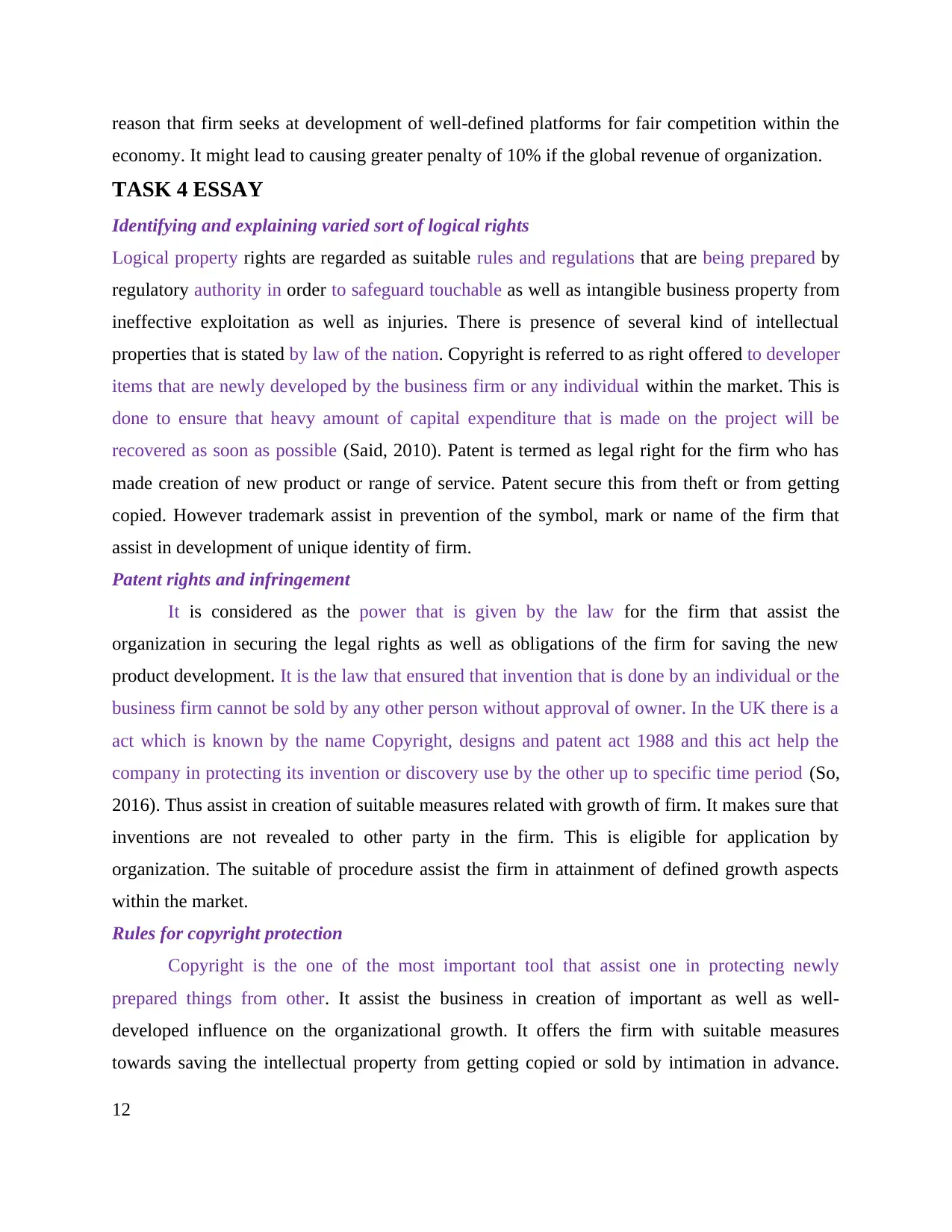
reason that firm seeks at development of well-defined platforms for fair competition within the
economy. It might lead to causing greater penalty of 10% if the global revenue of organization.
TASK 4 ESSAY
Identifying and explaining varied sort of logical rights
Logical property rights are regarded as suitable rules and regulations that are being prepared by
regulatory authority in order to safeguard touchable as well as intangible business property from
ineffective exploitation as well as injuries. There is presence of several kind of intellectual
properties that is stated by law of the nation. Copyright is referred to as right offered to developer
items that are newly developed by the business firm or any individual within the market. This is
done to ensure that heavy amount of capital expenditure that is made on the project will be
recovered as soon as possible (Said, 2010). Patent is termed as legal right for the firm who has
made creation of new product or range of service. Patent secure this from theft or from getting
copied. However trademark assist in prevention of the symbol, mark or name of the firm that
assist in development of unique identity of firm.
Patent rights and infringement
It is considered as the power that is given by the law for the firm that assist the
organization in securing the legal rights as well as obligations of the firm for saving the new
product development. It is the law that ensured that invention that is done by an individual or the
business firm cannot be sold by any other person without approval of owner. In the UK there is a
act which is known by the name Copyright, designs and patent act 1988 and this act help the
company in protecting its invention or discovery use by the other up to specific time period (So,
2016). Thus assist in creation of suitable measures related with growth of firm. It makes sure that
inventions are not revealed to other party in the firm. This is eligible for application by
organization. The suitable of procedure assist the firm in attainment of defined growth aspects
within the market.
Rules for copyright protection
Copyright is the one of the most important tool that assist one in protecting newly
prepared things from other. It assist the business in creation of important as well as well-
developed influence on the organizational growth. It offers the firm with suitable measures
towards saving the intellectual property from getting copied or sold by intimation in advance.
12
economy. It might lead to causing greater penalty of 10% if the global revenue of organization.
TASK 4 ESSAY
Identifying and explaining varied sort of logical rights
Logical property rights are regarded as suitable rules and regulations that are being prepared by
regulatory authority in order to safeguard touchable as well as intangible business property from
ineffective exploitation as well as injuries. There is presence of several kind of intellectual
properties that is stated by law of the nation. Copyright is referred to as right offered to developer
items that are newly developed by the business firm or any individual within the market. This is
done to ensure that heavy amount of capital expenditure that is made on the project will be
recovered as soon as possible (Said, 2010). Patent is termed as legal right for the firm who has
made creation of new product or range of service. Patent secure this from theft or from getting
copied. However trademark assist in prevention of the symbol, mark or name of the firm that
assist in development of unique identity of firm.
Patent rights and infringement
It is considered as the power that is given by the law for the firm that assist the
organization in securing the legal rights as well as obligations of the firm for saving the new
product development. It is the law that ensured that invention that is done by an individual or the
business firm cannot be sold by any other person without approval of owner. In the UK there is a
act which is known by the name Copyright, designs and patent act 1988 and this act help the
company in protecting its invention or discovery use by the other up to specific time period (So,
2016). Thus assist in creation of suitable measures related with growth of firm. It makes sure that
inventions are not revealed to other party in the firm. This is eligible for application by
organization. The suitable of procedure assist the firm in attainment of defined growth aspects
within the market.
Rules for copyright protection
Copyright is the one of the most important tool that assist one in protecting newly
prepared things from other. It assist the business in creation of important as well as well-
developed influence on the organizational growth. It offers the firm with suitable measures
towards saving the intellectual property from getting copied or sold by intimation in advance.
12
⊘ This is a preview!⊘
Do you want full access?
Subscribe today to unlock all pages.

Trusted by 1+ million students worldwide
1 out of 15
Related Documents
Your All-in-One AI-Powered Toolkit for Academic Success.
+13062052269
info@desklib.com
Available 24*7 on WhatsApp / Email
![[object Object]](/_next/static/media/star-bottom.7253800d.svg)
Unlock your academic potential
Copyright © 2020–2025 A2Z Services. All Rights Reserved. Developed and managed by ZUCOL.





